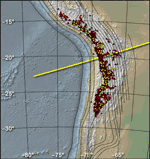 Many natural phenomena that occur on the Earth's surface due to processes occurring in the upper mantle of the Earth. Some of them are Crustal and Deep Earthquakes. Earthquakes - clear evidence of the inner life of our Earth. An earthquake is the result of a sudden release of energy in the Earth's lithosphere that creates seismic waves. At the Earth's surface, earthquakes manifest themselves by shaking and sometimes displacing the ground. When a large earthquake epicenter is located offshore, the seabed sometimes suffers sufficient displacement to cause a tsunami. The shaking in earthquakes can also trigger landslides and occasionally volcanic activity. The majority of tectonic earthquakes originate at the ring of fire in depths not exceeding tens of kilometers. Earthquakes occurring at a depth of less than 70 km are classified as 'shallow-focus' earthquakes, while those with a focal-depth between 70 and 300 km are commonly termed 'mid-focus' or 'intermediate-depth' earthquakes.
Many natural phenomena that occur on the Earth's surface due to processes occurring in the upper mantle of the Earth. Some of them are Crustal and Deep Earthquakes. Earthquakes - clear evidence of the inner life of our Earth. An earthquake is the result of a sudden release of energy in the Earth's lithosphere that creates seismic waves. At the Earth's surface, earthquakes manifest themselves by shaking and sometimes displacing the ground. When a large earthquake epicenter is located offshore, the seabed sometimes suffers sufficient displacement to cause a tsunami. The shaking in earthquakes can also trigger landslides and occasionally volcanic activity. The majority of tectonic earthquakes originate at the ring of fire in depths not exceeding tens of kilometers. Earthquakes occurring at a depth of less than 70 km are classified as 'shallow-focus' earthquakes, while those with a focal-depth between 70 and 300 km are commonly termed 'mid-focus' or 'intermediate-depth' earthquakes.
In subduction zones, where older and colder oceanic crust descends beneath another tectonic plate, deep-focus earthquakes may occur at much greater depths (ranging from 300 up to 700 kilometers). These seismically active areas of subduction are known as Wadati-Benioff zones.
|

